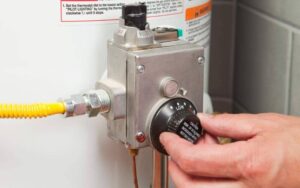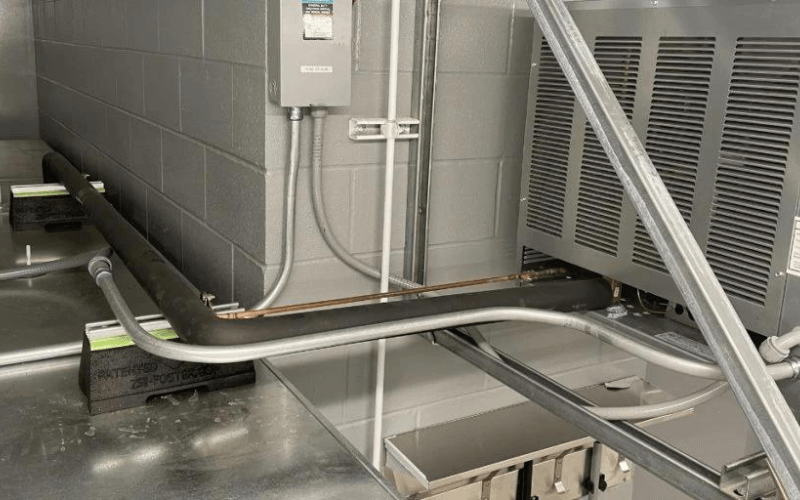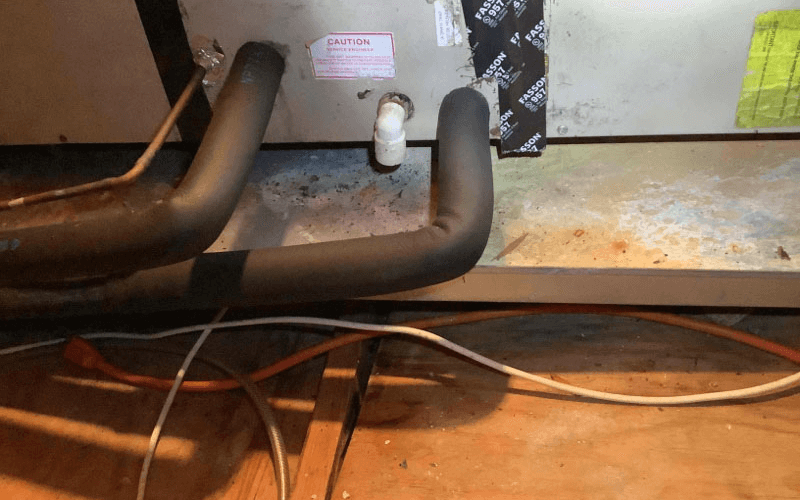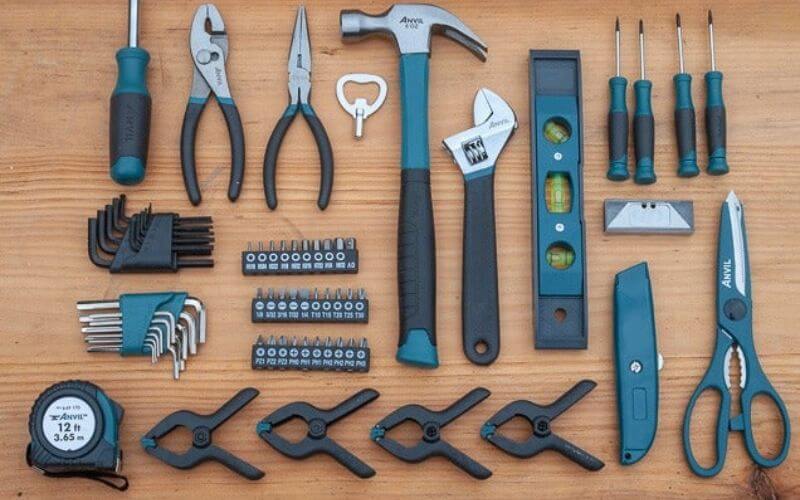Outdoor tankless water heaters provide hot water in homes efficiently and conveniently. Frigid winter temperatures can damage these units. Freezing heater water can burst pipes and cost a lot to fix. Protecting your outdoor tankless water heater from freezing is essential to avoid this.
Table of Contents
ToggleThis article covers how to keep your tankless water heater from freezing. To prolong and improve the efficiency of your outdoor tankless water heater, we will examine insulation, heat tape, coverings, freeze protection devices, and other ideas.
These measures will protect your investment and provide hot water even in the coldest winters.
What Are Water Heater Freezing Risks?
Understand the threats before discussing how to prevent your outdoor tankless water heater from freezing.
When the temperature dips below freezing, tankless water heater water can freeze and expand. This expansion puts tremendous pressure on pipes and other unit components, causing cracks, leaks, and bursts. This can cause expensive repairs and leave you without hot water until the problem is fixed.
Freezing temperatures might damage the tankless water heater and reduce its efficiency. Water swells and blocks water flow as it freezes, lowering heater effectiveness. It can lower water pressure and increase energy use.
If the tankless water heater’s water continually freezes and thaws, the expansion and contraction might weaken the pipes, increasing the risk of future problems. Avoiding freezing and protecting your outdoor tankless water heater requires preventive actions.
Also, Read: How to Unfreeze Tankless Water Heater?
Ways Of Protecting Outdoor Tankless Water Heaters:
Insulating Tankless Water Heaters:
Insulating an outdoor tankless water heater is one of the best ways to prevent freezing. Insulating the water heater keeps heat in and cold air out.
Tankless water heater pipes should be insulated first. Hardware stores sell foam pipe insulation sleeves. Measure and cut insulation sleeves to pipe length. Secure the insulation around the pipes with tape or zip ties. Pay attention to exposed pipes exposed to chilly air.
Insulate the tankless water heater’s housing or enclosure next. Water heater insulation, blankets, or jackets can do this. Fiberglass or foam blankets can be draped around the device. Insulating the water heater should not block vents or ventilation. Insulation buffers cold air from reaching the tankless water heater, preventing freezing and ensuring excellent performance even in freezing temperatures.
Heat Tape Wrapping:
Heat tape can also prevent outdoor tankless water heaters from freezing. Heat tape, trace, or cable generates heat when powered. This heat keeps the water heater and pipe warm even in cold conditions.
Remove trash and clean your tankless water heater before wrapping it with heat tape. Unplug the water heater first. Inspect the unit for damage and wear before continuing.
Tankless water heater pipes, valves, and connections should be heat-taped. Install heat tape per manufacturer’s instructions, and don’t overlap or cross it to avoid hotspots.
Use tape or zip ties to secure heat tape, but don’t obstruct ventilation or water heater airflow. After placing the heat tape, plug it in and follow the manufacturer’s temperature control instructions.
Check and repair wear, damage, and malfunction. Be sure heat tape is correctly put and powered on, especially in winter. Heat tape keeps your tankless water heater from freezing and ensures hot water in winter.
Also, Read: What Size Tankless Water Heater For Mobile Home?
Using a Tankless Water Heater Cover:
A cover keeps your outdoor tankless water heater from freezing. A cover shields the water heater from snow, rain, wind, and extreme temperatures.
Choose an outdoor tankless water heater cover that fits its size and model. Choose waterproof, durable covers. Clean and dry your tankless water heater before covering it. Clean leaves and grime around the water heater.
Clean and dry the water heater, then cover it lightly. Keep the cover fitted to avoid blowing off in strong gusts. Some covers contain straps or drawstrings for a tighter fit. Tankless water heater covers should ventilate and protect. Make sure the cover doesn’t block device airflow. The water heater runs more effectively because circulation avoids heat buildup.
Check tankless water heater covers for wear, tears, and damage periodically. If the cover wears out or loses protection, replace it. Remove the cover in moderate weather to prevent moisture on the water heater.
Freeze Protection Device Installation:
Freeze protection devices help keep outdoor tankless water heaters from freezing. These devices avoid freezing and unit damage by monitoring temperature and acting when it drops below a certain level.
Many freezing sensors and alarms exist. The system operates when water pipe freeze sensors reach a critical temperature. However, freeze alarms sound or send an alert as the temperature drops, allowing you to act.
Before installing your tankless water heater, check the manufacturer’s instructions and add a freeze-protection device. Install the freeze prevention device where the temperature may be monitored. Position the device to detect temperature changes and activate it. Place and fasten it per the manufacturer’s directions.
Safe and secure, a freeze protection system keeps your outdoor tankless water heater from freezing. These devices automatically detect and respond to temperature changes to prevent pipe freezing and unit damage.
Winter Water Heater Draining
In winter, drain your outdoor tankless water heater to prevent freezing. Remove all water from the unit and pipes to avoid freezing and frost. Turn off and unplug the water heater before draining. Let the gadget cool completely before proceeding to prevent burns.
Access the tankless water heater drain valve. A spigot-shaped valve is normally near the bottom of the unit. Garden hoses should be connected to drain valves and placed in drainage areas.
Turn the drain valve counterclockwise. This enables the water heater to flow through the garden hose. Water may drain slowly depending on the tankless water heater size. Allow the process to finish.
Draining the water heater may not stop freezing. In cold weather, unit and pipe moisture might freeze. Insulation, heat tape, or tankless water heater covers increase safety.
Draining your outdoor tankless water heater in winter prevents freezing and extends its life. Water removal from the unit and pipes prevents ice buildup and damage, keeping your water heater functioning smoothly.
Other Freezing Prevention Tips
There are various alternative ways to prevent freezing and protect your outdoor tankless water heater:
- Clear snow, trash, and vegetation around the water heater for optimal airflow and ventilation. This prevents moisture buildup and optimizes device performance.
- Be informed of weather forecasts and take precautions during extreme cold weather. Consider heat lamps or insulation for sensitive areas.
- Inspect the water heater and Pipes regularly for leaks or drips. A little leak can freeze and harm over time. Fix or replace broken parts immediately.
- Remove and drain any hoses attached to your outdoor water heater or faucets. This keeps residual water from freezing and damaging the water heater or plumbing system.
- Properly maintain heat by placing a space heater or heat lamp near the water heater. This keeps the temperature up and prevents freezing.
- Choose a freeze-proof model optimized for freezing temperatures when buying or replacing an outdoor tankless water heater. These devices have freeze protection to prevent damage.
Conclusion:
Keep your outdoor tankless water heater from freezing to extend its life and hot water supply. By understanding freezing threats and taking precautions, you can protect your investment and use your water heating system even in the coldest winters.
Keep up with weather forecasts and take precautions when severe cold is predicted. Maintenance and inspection of the water heater will help find and fix issues quickly.
These methods can keep your outdoor tankless water heater from freezing and provide hot water throughout winter. Water heater damage prevention saves money and gives peace of mind in cold weather.
FAQ:
Can you provide cover for an outdoor tankless water heater?
Even with versions designed primarily for outdoor usage, it is still advised to position them under some cover. This is more of an issue for electric models than gas models due to maintaining all electrical components as dry as possible throughout the seasons.
How is an outdoor tankless water heater weatherproofed?
By preventing heat from leaving in the first place, you can keep the unit from freezing. The pipes linked to the tankless water heater should first be insulated with fiberglass or polyethylene. Another technique for preventing freezing is heat tape. However, it only works when there is power.
Does the outdoor tankless water heater need to be insulated?
Yes, the outdoor heater needs to be well insulated as insulation can provide extra protection for your tankless water heater and plumbing lines, which are prone to freezing in cold weather. Both fiberglass and heat tape are excellent choices.





















